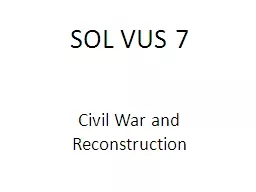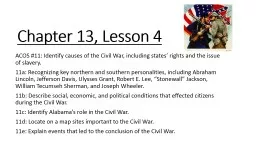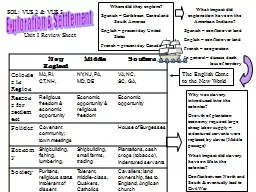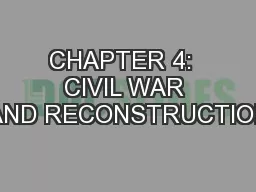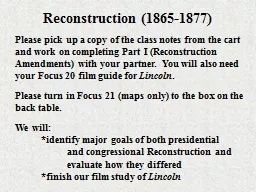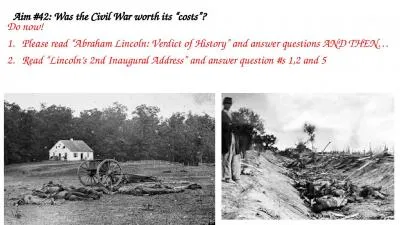PPT-SOL VUS 7 Civil War and Reconstruction
Author : jane-oiler | Published Date : 2020-04-06
Leading up to the Civil War Many Southerners were afraid of slave revolts so what did they do to try and prevent those revolts Who were the two most famous men
Presentation Embed Code
Download Presentation
Download Presentation The PPT/PDF document " SOL VUS 7 Civil War and Reconstruction" is the property of its rightful owner. Permission is granted to download and print the materials on this website for personal, non-commercial use only, and to display it on your personal computer provided you do not modify the materials and that you retain all copyright notices contained in the materials. By downloading content from our website, you accept the terms of this agreement.
SOL VUS 7 Civil War and Reconstruction: Transcript
Leading up to the Civil War Many Southerners were afraid of slave revolts so what did they do to try and prevent those revolts Who were the two most famous men responsible for slave revolts. Transformation of American Society. Unit 5 Overview. Period 5: 1844-1877. As the nation expanded and its population grew, regional tensions, especially over slavery, led to a civil war — the course and aftermath of which transformed American society.. CIVIL. . WAR. SS8H6 The student will analyze the impact of the Civil War and Reconstruction on Georgia. NULLIFICIATION. Tariff: a tax on imported goods designed to keep out competition. . In the 1800s, Congress passed several protective tariffs. . Poorlincoln. . Political Parties of the North . Northern Democrats Split following the death of Stephen Douglas. War Democrats and Peace Democrats . War= Support Lincoln . Peace= want war to end- extremist were the Copperheads . Texas . Civil War Museum . Music. Women in War. Medicine. The Civil War: Battlefield Medicine, Music & . The . Civil War Soldier with The . Texas . Civil War Museum. Outline . . I. Experience . . ** . Southern state governments: aspirations, achievements, failures. *** . Role of African Americans in politics, education, and the economy. **** . Compromise of 1877. ***** . Impact of Reconstruction. 11a: Recognizing key northern and southern personalities, including Abraham Lincoln, Jefferson Davis, Ulysses Grant, Robert E. Lee, “Stonewall” Jackson, William Tecumseh Sherman, and Joseph Wheeler.. Compromise. --division of powers, senate vs. house of republicans, etc. is built into the Constitution.. Encourages differences of opinion into the political arena. and it has largely been a success. . Where did they explore?. . Spanish – Caribbean, Central and South America. English – present day United States. French – present day Canada. Unit I Review Sheet. The English Come to the New World. ESSENTIAL KNOWLEDGE. Conflict over the expansion of slavery into the territories west of the Mississippi River in the 1820s-1850s caused tensions to mount between northern (manufacturing) states and southern (farming) states. The real battle wasn’t about slavery, but POWER in GOVERNMENT and whether factories or farming would be the basis of our nation’s economy.. 13. th. Amendment. grandfather clause. 14th Amendment. Jim Crow. 15. th. Amendment. Ku Klux Clan. 16. th. Amendment. literacy test. Abraham Lincoln. martial law. Andrew Johnson. poll tax. assassination. Please pick up a copy of the class notes from the cart and work on completing Part I (Reconstruction Amendments) with your partner. You will also need your Focus 20 film guide for . Lincoln. .. Please turn in Focus 21 (maps only) to the box on the back table.. K. now. , what you . W. ant. to know about Period 5: 1844-1877.. K. W. L. PERIOD 5: . 1844-1877. “Antebellum . Expansion, . Civil War, and Reconstruction”. Overview. This period is covers the antebellum period, the Civil War, and the reconstruction period. The main focus is on the social, political, and economic division amongst Americans. Three themes to guide us through the period are:. CIVIL. . WAR. SS8H6 The student will analyze the impact of the Civil War and Reconstruction on Georgia. NULLIFICIATION. Tariff: a tax on imported goods designed to keep out competition. . In the 1800s, Congress passed several protective tariffs. . Do now! . Please read “Abraham Lincoln: Verdict of History” and answer questions AND THEN…. Read “Lincoln’s 2nd Inaugural Address” and answer question #s 1,2 and 5. (I) ELECTION OF 1864. Lincoln at odds with Congress over Reconstruction policy.
Download Document
Here is the link to download the presentation.
" SOL VUS 7 Civil War and Reconstruction"The content belongs to its owner. You may download and print it for personal use, without modification, and keep all copyright notices. By downloading, you agree to these terms.
Related Documents

